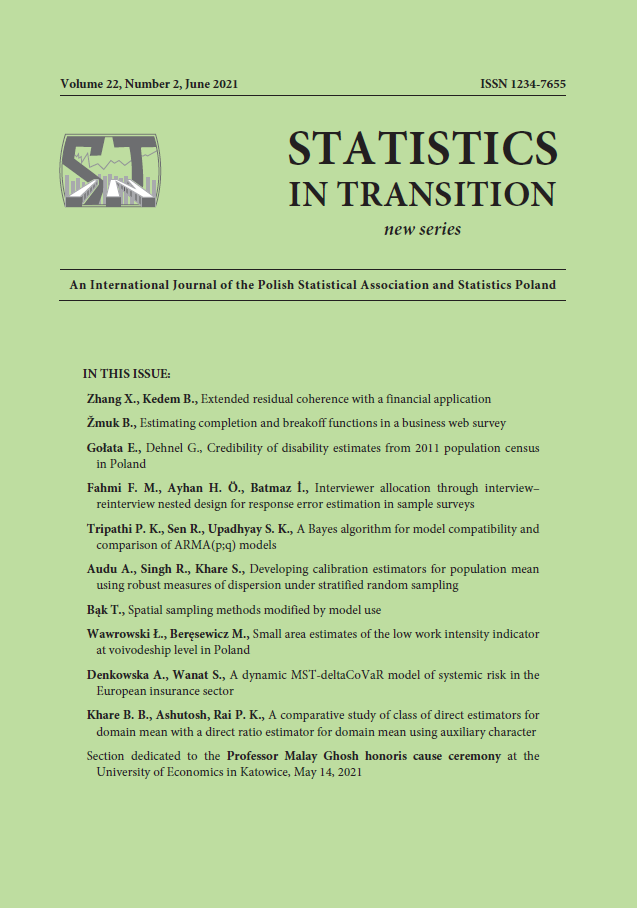ARTICLE
ABSTRACT
A business web survey should be of an appropriate length. On the one hand it should include all the questions which are important to the researcher, but on the other hand, it should not be too long as the breakoff rate in this case tends to be high, resulting in a low response rate. In consequence, the researcher is forced to invest more time and money in order to reach a sample size which would enable an appropriately performed statistical analysis. In this paper, completion and breakoff times are observed and compared across different questionnaire and respondent characteristics. A regression modelling approach has been adopted to estimate the completion and breakoff functions to help a researcher determine which respondents completed a questionnaire and which broke it off too quickly or too slowly. By omitting such respondents, a researcher is able to obtain the relevant estimates more efficiently. In addition, the completion and breakoff functions offer a better insight into the completion and breakoff development rates, allowing the researcher to make a betterinformed decision as to whether the survey requires any modifications or not.
KEYWORDS
breakoff function, business web survey, completion function, questionnaire
JEL
C12, C20, C83
REFERENCES
1ka, (2020a). Osnovna priporočila: Kaj pomeni kompleksnost ankete? (in Slovenian). Available at: https://www.1ka.si/d/sl/spletne-ankete/osnovna-priporocila/kajpomeni- kompleksnost-ankete [02 June 2020].
1ka, (2020b). Osnovna priporočila: Kako dolga naj bo moja anketa? (in Slovenian). Available at: https://www.1ka.si/d/sl/spletne-ankete/osnovna-priporocila/kakodolga- naj-bo-moja-anketa [02 June 2020].
Blumenberg, C., Zugna, D., Popovic, M., Pizzi, C., Barros, A.J.D., Richiardi, L., (2018). Questionnaire Breakoff and Item Nonresponse in Web-Based Questionnaires: Multilevel Analysis of Person-Level and Item Design Factors in a Birth Cohort, Journal of Medical Internet Research, Vol. 20, No. 12., pp. 1-11, DOI: 10.2196/11046.
Crawford, S. D., Couper, M. P., Lamias, M. J., (2001). Web surveys: Perceptions of burden, Social Science Computer Review, Vol. 19, No. 2, pp. 146-162.
Feng, C., Wang, H., Lu, N., Chen, T., He, H., Lu, Y., Tu, X. M., (2014). Logtransformation and its implications for data analysis, Shanghai archives of psychiatry, Vol. 26, No. 2, pp. 105-109.
Galesic, M., (2006). Dropouts on the Web: Effects of Interest and Burden Experienced During an Online Survey, Journal of Official Statistics, Vol. 22, No. 2, pp. 313-328.
Groves, R. M., (2006). Nonresponse Rates and Nonresponse Bias in Household Surveys, Public Opinion Quarterly, Vol. 70, No. 5, pp. 646-675.
G?ritz, A. S., (2006). Incentives in Web Studies: Methodological Issues and a Review, International Journal of Internet Science, Vol. 1, No. 1, pp. 58-70.
Kish, L., (1995). Survey Sampling, New York: John Wiley & Sons.
Mittereder, F. K., (2019). Predicting and Preventing Breakoff in Web Surveys, dissertation, University of Michigan, pp. 1-762, available at: https://isr.umich.edu/wp-content/uploads/2019/04/Dissertation_FinalSubmit_V03.pdf.
Narodne novine, (2007). The National Classification of Economic Activities. Official Gazette, 16(58).
Narodne novine, (2011). The Enterprises Act. Official Gazette, 20(152).
Narodne novine, (2015). The Accounting Act. Official Gazette, 24(78).
Peytchev, A., (2009). Survey Breakoff, Public Opinion Quarterly, Vol. 73, No. 1, pp. 74-97.
Peytchev, A., (2011). Breakoff and Unit Nonresponse Across Web Surveys, Journal of Official Statistics, Vol. 27, No. 1, pp. 33-47.
Žmuk, B., (2017). Impact of Questionnaire Length and Complexity on Survey Time: Comparison of Two Business Web Questionnaire Versions, Metodološki zvezki - Advances in Methodology and Statistics, Vol. 14, No. 2, pp. 49-74.
